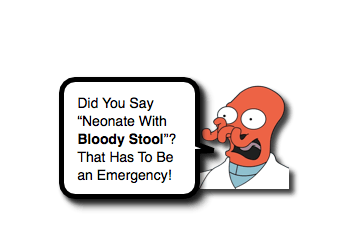Neonate with Bloody Stool

Gastrointestinal Bleeding in Kids
- Gastrointestinal bleeding (GIB) is commonly encountered in children. [Romano, 2017; O’Neill, 2016]
- It will be noticed… and will cause concern!
- Some resources out there may help mitigate the potential panic (momlovesbest.com), but be prepared for what conditions need to be considered.
- Causes vary with age (like everything in pediatrics)
- See Table on prior Morsel for a quick review
- Mortality from acute GIB in children is low. [Romano, 2017; Teach, 1994]
- Rectal bleeding in infancy is often a self-limited condition. [Arvola, 2006]
- Most are able to be discharged from the ED. [Teach, 1994]
- With a good H+P, EM providers are able to accurately make a presumptive Dx. [Teach, 1994]
Neonate with Bloody Stool: DDx
- Emergent Considerations
- Necrotizing Enterocolitis
- Uncommon in term neonates, but can occur.
- Other symptoms: emesis and abdominal distension
- Xray findings = hepatobiliary gas, pneumatosis intestinalis, pneumoperitoneum
- U/S findings: [Bohnhorst, 2013]
- Portal venous gas
- Pneumatosis intestinalis
- Increased wall echogenicity
- Bowel wall thickening or thinning
- Absent perfusion or reduced peristalsis
- Free fluid
- Malrotation w/ Volvulus
- May cause hematochezia, but child will be ill appearing.
- 75% present in first month of life
- Other symptoms: bilious emesis and abdominal distension
- Xray findings are often not specific
- Hirschsprung Disease
- Presentation age depends upon length of segment involved.
- Neonates may have had delayed passage of meconium.
- Older infants and children may have “chronic constipation.”
- Abdominal distension and emesis are also seen.
- Presentation age depends upon length of segment involved.
- Systemic Coagulopathy
- Vitamin K Deficiency needs to be considered in any neonate with suspected bleeding. Ask whether Vit K was given after birth.
- Maternal thrombocytopenia – transferred antibodies against platelets can lead to neonatal thrombocytopenia
- Disseminated Intravascular Coagulation – potentially related to sepsis
- Infectious Colitis
- Viral infections can lead to bloody stool in neonates.
- Salmonella, shigella, and yersina are unusual in neonates. [Arvola, 2006]
- May be related to low numbers of norma flora in gut flora. [Arvola, 2006]
- Necrotizing Enterocolitis
- Other Conditions related to Rectal Bleeding in Infants
- Swallowed Maternal Blood
- Possibly related to swallowed blood during birth or from breastfeeding from cracked nipples.
- The Apt test can be useful for this diagnosis:
- Qualitative test (color-change) using alkali to detect maternal hemoglobin
- Fetal hemoglobin is resistant to alkali (i.e., stays pink in test tube), but Adult hemoglobin with be hydrolyzed by alkali (i.e., turn yellow-brownish).
- Milk Protein Enterocolitis
- Presents most commonly between 1st month and 1st year of age.
- Will have a normal examination and appear well.
- Elimination of milk protein from diet is commonly done, but improvement does not prove the diagnosis.
- Recurrence of the problem with re-instituting the milk protein will help reduce number of false-positive diagnoses. [Arvola, 2006]
- Often blamed for bloody stool in well appearing neonate, but actual prevalence is likely less than believed. [Arvola, 2006]
- Perianal/Rectal Fissure
- Typically related to passage of large and/or hard stool.
- Typically not an issue in the neonate, but worth looking for.
- Swallowed Maternal Blood
Moral of the Morsel
- Think Worse First! Bloody stool in a neonate’s diaper may be a benign condition, but don’t get ahead of yourself. Think about the big, bad, and ugly.
- Vitamin K? Easily overlooked. Ask about the Vit K Shot!
- Sick or Not Sick? The child’s physical exam is important.
- The emergent conditions can be tricky to detect early on, but they don’t typical present with only hematochezia.
- Hematochezia PLUS another finding is concerning!
- Toxic appearance, abdominal distension, Shock? These are not due to benign disorders.
References
Romano C1, Oliva S1, Martellossi S1, Miele E1, Arrigo S1, Graziani MG1, Cardile S1, Gaiani F1, de’Angelis GL1, Torroni F1. Pediatric gastrointestinal bleeding: Perspectives from the Italian Society of Pediatric Gastroenterology. World J Gastroenterol. 2017 Feb 28;23(8):1328-1337. PMID: 28293079. [PubMed] [Read by QxMD]
O’Neil AM1, Homme JL1. Evaluation of Hematochezia in a Two-Day-Old Infant. J Emerg Med. 2016 Jan;50(1):41-3. PMID: 26603360. [PubMed] [Read by QxMD]
Bohnhorst B1. Usefulness of abdominal ultrasound in diagnosing necrotising enterocolitis. Arch Dis Child Fetal Neonatal Ed. 2013 Sep;98(5):F445-50. PMID: 23572342. [PubMed] [Read by QxMD]
Arvola T1, Ruuska T, Keränen J, Hyöty H, Salminen S, Isolauri E. Rectal bleeding in infancy: clinical, allergological, and microbiological examination. Pediatrics. 2006 Apr;117(4):e760-8. PMID: 16585287. [PubMed] [Read by QxMD]
Teach SJ1, Fleisher GR. Rectal bleeding in the pediatric emergency department. Ann Emerg Med. 1994 Jun;23(6):1252-8. PMID: 8198299. [PubMed] [Read by QxMD]

